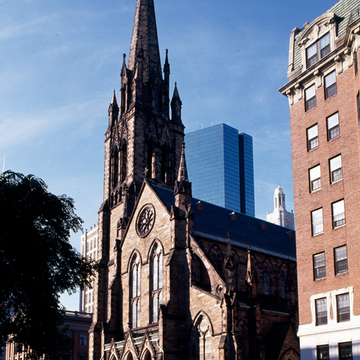The decision of the Arlington Street Church (BB2) congregation to build in the new Back Bay development signaled an exodus of established churches from the city center. Two congregations that followed in the 1860s chose to build churches in a variation of the Gothic Revival, the most popular style for religious groups at this time. Emmanuel Church began as a small Gothic chapel without a tower and constructed of Roxbury puddingstone. Its nave was originally oriented north-south perpendicular to the street. As completed in 1862, the church was a small urban counterpart to Alexander Esty's Grace Episcopal Church (see NW15) built in Newton in 1872–1873. The most dramatic element of the interior of Emmanuel Church is the Pilgrim's Progress window (Frederic Crownin-shield, 1899–1900), a panoramic depiction of Immanuel's Land from John Bunyun's Pilgrim's Progress. Additions on the east and west in 1899 by Frederick R. Allen reoriented the church so that the nave now runs parallel to the street. In 1924, Allen and Collens added to the west of the complex the Leslie Lindsay Memorial Chapel, given in memory of a victim of the Lusitania sinking. A symbol of the Arts and Crafts movement in Boston, the chapel incorporates a high altar and stained glass by Sir Ninian Comper and fine iron work by Frank Koralewsky.
Nearby, the Church of the Convenant was built in 1866 and designed by Richard M. Upjohn. The pronounced vertical proportions and archaeologically correct detailing, including flying buttresses, call to mind the character of Trinity Church in New York City by Upjohn's father. Unlike Trinity in New York, however, the Church of the Covenant














